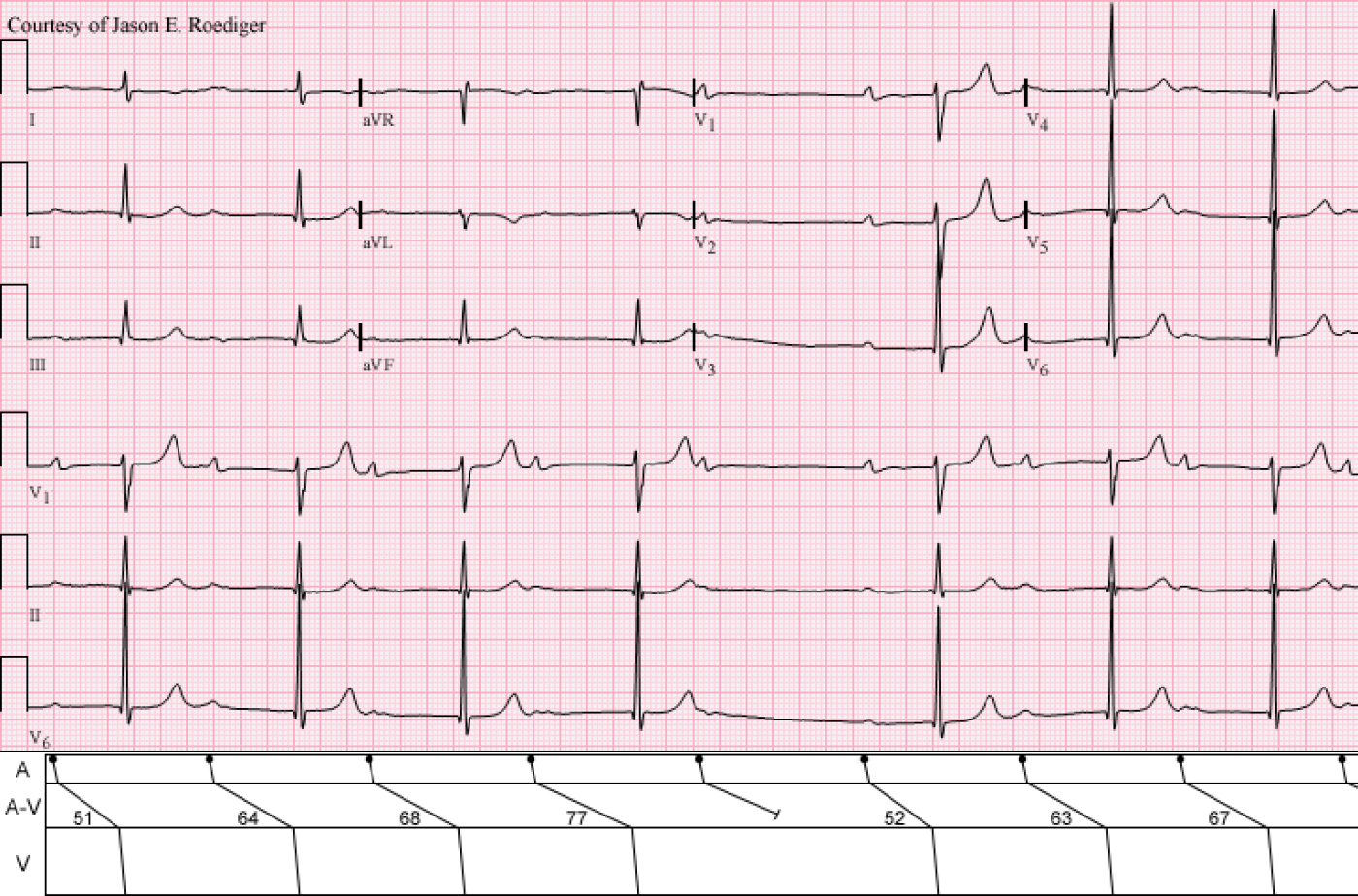Submitted by jer5150 on Sun, 01/06/2013 - 19:03
This ECG was taken from an 87-year-old black man and was diagnosed by the reviewing cardiologist as "complete AV block".
Is that really the interpretation or is it something else?
Rate this content:
-

- jer5150's blog
- Log in or register to post comments
All our content is FREE & COPYRIGHT FREE for non-commercial use
Please be courteous and leave any watermark or author attribution on content you reproduce.



Comments
He's back to the warning track!
...back, back, back, aannd it's outta here!
I imagine that would be the color commentary for this strip if a baseball announcer got ahold of it. Looks like a case of AV Wenckebach with PR-intervals Of Unusual Size (P.R.O.U.S.).
Very neat strip!
Christopher
sixlettervariable.blogspot.com
ems12lead.com
Seems like simple wenckebach,
Seems like simple wenckebach, PRI increase, increase, increase drop beat
I concur...
Wenckebach
Caprice Hill Black
wenckeback.
wenckeback.
INTERPRETATION
INTERPRETATION:
1. Sinus bradycardia (rate about 49/min) with . . .
2. . . . Type I A-V (nodal) block manifest in the form of . . .
3. . . . Wenckebach periods.
COMMENTS:
I found this ECG by searching our computer database for the longest P-R intervals I could find. Here, the shortest P-R interval (0.51s) is longer than the longest P-R interval seen in most of the typical cases of Type I A-V block. The longest P-R interval reaches a much prolonged length of 0.77s! On Facebook, one responder simply interpreted this as "A-V dissociation" which is not a diagnosis but rather a secondary finding that is always caused by something else. I can only imagine that they called it that by not wanting to believe that P-R intervals can attain such great lengths. Again, here there is no A-V dissociation and all sinus impulses are conducting except for the 5th one. It's worth emphasizing that the longest P-R interval ever documented in a publication reached a astounding duration of 1.10s!!! Personally, the longest P-R interval I've ever witnessed, on a patient I was monitoring, was 1.04s! Note that the cycle encompassing the "dropped" beat is less-than twice the shortest cycle. The ratio of the Wenckebach periods is probably 5:4.
Jason E. Roediger - Certified Cardiographic Technician (CCT)
[email protected]
Wenckebach with Very Long PR Interval
Nice example by Jason illustrating the concept that the PR interval may be very long and still conduct! Nicely drawn laddergram clearly illustrates the KEY features of Wenckebach.
THANKS for showing this interesting example of Wenckebach - : )
Ken Grauer, MD www.kg-ekgpress.com [email protected]
January Challenge
It initially appeared to be Wenckebach to me (type I) with P-P is consistency and P-R interval lengthens until the drop (ker-plop) occurs. That is an extremely long P-R. I wonder the reasoning of the CHB conclusion (?). I'm glad to read the other comments to confirm the 2 degree.
Thanks for the research and great example.
I'm a newbie - a little lost but anxious to learn my way around 8)
Mary Jane Ross CCT